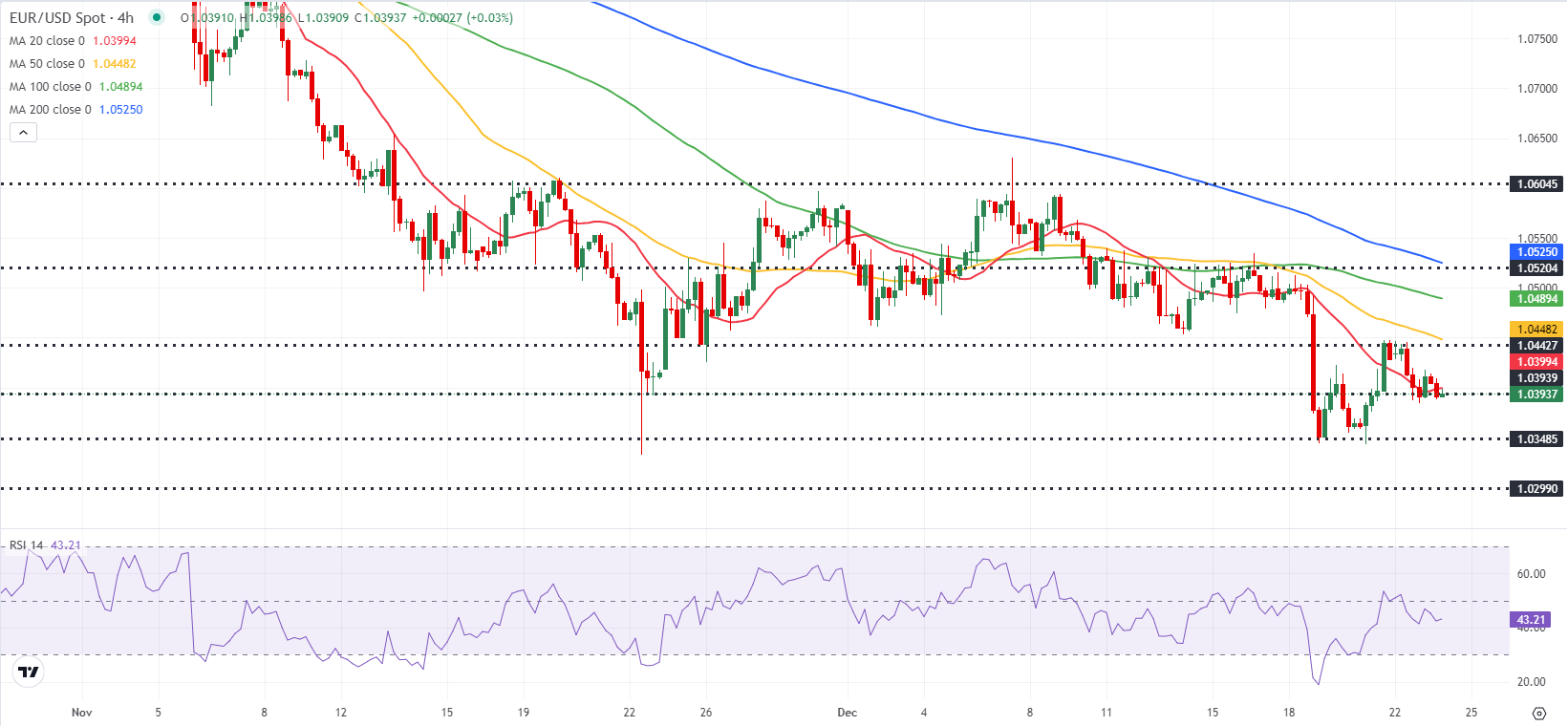EUR/USD Forecast: Euro looks to extend sideways action
- EUR/USD trades in a narrow channel near 1.0400 early Tuesday.
- Trading action is likely to remain subdued on Christmas Eve.
- Technical picture highlights the pair's indecisiveness in the near term.
EUR/USD closed marginally lower on Monday but the pair remained confined within a tight channel. The pair fluctuates near 1.0400 in the European morning on Tuesday as trading conditions thin out on Christmas Eve.
Euro PRICE Last 7 days
The table below shows the percentage change of Euro (EUR) against listed major currencies last 7 days. Euro was the weakest against the US Dollar.
| USD | EUR | GBP | JPY | CAD | AUD | NZD | CHF | |
|---|---|---|---|---|---|---|---|---|
| USD | 1.09% | 1.16% | 1.87% | 0.88% | 1.96% | 2.33% | 0.60% | |
| EUR | -1.09% | 0.07% | 0.75% | -0.21% | 0.85% | 1.22% | -0.48% | |
| GBP | -1.16% | -0.07% | 0.71% | -0.27% | 0.78% | 1.15% | -0.54% | |
| JPY | -1.87% | -0.75% | -0.71% | -0.95% | 0.14% | 0.49% | -1.17% | |
| CAD | -0.88% | 0.21% | 0.27% | 0.95% | 1.07% | 1.43% | -0.26% | |
| AUD | -1.96% | -0.85% | -0.78% | -0.14% | -1.07% | 0.36% | -1.33% | |
| NZD | -2.33% | -1.22% | -1.15% | -0.49% | -1.43% | -0.36% | -1.67% | |
| CHF | -0.60% | 0.48% | 0.54% | 1.17% | 0.26% | 1.33% | 1.67% |
The heat map shows percentage changes of major currencies against each other. The base currency is picked from the left column, while the quote currency is picked from the top row. For example, if you pick the Euro from the left column and move along the horizontal line to the US Dollar, the percentage change displayed in the box will represent EUR (base)/USD (quote).
Mixed macroeconomic data releases from the US limited the US Dollar's (USD) gains on Monday and helped EUR/USD find a foothold.
The US Census Bureau reported that Durable Goods Orders declined by 1.1% on a monthly basis in November, coming in worse than the market expectation for a decrease of 0.4%. Meanwhile, the Conference Board's Consumer Confidence Index fell to 104.7 in December from 112.8 (revised from 111.7) in November. On a positive note, New Home Sales increased by 5.9% in November following the 14.8% decrease recorded in October.
The economic calendar will not feature any macroeconomic data releases. Bond and stock markets in the US will operate half day on Tuesday and remain closed on Christmas Day on Wednesday.
EUR/USD Technical Analysis
The Relative Strength Index (RSI) indicator on the 4-hour chart stays slightly below 50 but EUR/USD fluctuates at around the 20-period Simple Moving Average (SMA), highlighting a lack of directional momentum.
First resistance could be spotted at 1.0440 (static level) before 1.0490-1.0500, (100-period Simple Moving Average (SMA), static level). On the downside, 1.0350 (static level) and 1.0300 (static level, round level) could be seen as next support levels if EUR/USD confirms 1.0400 (static level, round level) as resistance.
Euro FAQs
The Euro is the currency for the 19 European Union countries that belong to the Eurozone. It is the second most heavily traded currency in the world behind the US Dollar. In 2022, it accounted for 31% of all foreign exchange transactions, with an average daily turnover of over $2.2 trillion a day. EUR/USD is the most heavily traded currency pair in the world, accounting for an estimated 30% off all transactions, followed by EUR/JPY (4%), EUR/GBP (3%) and EUR/AUD (2%).
The European Central Bank (ECB) in Frankfurt, Germany, is the reserve bank for the Eurozone. The ECB sets interest rates and manages monetary policy. The ECB’s primary mandate is to maintain price stability, which means either controlling inflation or stimulating growth. Its primary tool is the raising or lowering of interest rates. Relatively high interest rates – or the expectation of higher rates – will usually benefit the Euro and vice versa. The ECB Governing Council makes monetary policy decisions at meetings held eight times a year. Decisions are made by heads of the Eurozone national banks and six permanent members, including the President of the ECB, Christine Lagarde.
Eurozone inflation data, measured by the Harmonized Index of Consumer Prices (HICP), is an important econometric for the Euro. If inflation rises more than expected, especially if above the ECB’s 2% target, it obliges the ECB to raise interest rates to bring it back under control. Relatively high interest rates compared to its counterparts will usually benefit the Euro, as it makes the region more attractive as a place for global investors to park their money.
Data releases gauge the health of the economy and can impact on the Euro. Indicators such as GDP, Manufacturing and Services PMIs, employment, and consumer sentiment surveys can all influence the direction of the single currency. A strong economy is good for the Euro. Not only does it attract more foreign investment but it may encourage the ECB to put up interest rates, which will directly strengthen the Euro. Otherwise, if economic data is weak, the Euro is likely to fall. Economic data for the four largest economies in the euro area (Germany, France, Italy and Spain) are especially significant, as they account for 75% of the Eurozone’s economy.
Another significant data release for the Euro is the Trade Balance. This indicator measures the difference between what a country earns from its exports and what it spends on imports over a given period. If a country produces highly sought after exports then its currency will gain in value purely from the extra demand created from foreign buyers seeking to purchase these goods. Therefore, a positive net Trade Balance strengthens a currency and vice versa for a negative balance.



